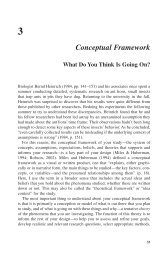Mixed Integer Linear Programming in Process Scheduling: Modeling ...
Mixed Integer Linear Programming in Process Scheduling: Modeling ...
Mixed Integer Linear Programming in Process Scheduling: Modeling ...
Create successful ePaper yourself
Turn your PDF publications into a flip-book with our unique Google optimized e-Paper software.
136 FLOUDAS AND LIN<br />
1 2 3 4 5 6 7 H-1 H H+1 Time<br />
1 2 3<br />
(a) Discrete-time representation<br />
(b) Cont<strong>in</strong>uous-time representation<br />
Figure 3. Discrete and cont<strong>in</strong>uous representations of time.<br />
with these time <strong>in</strong>tervals, as illustrated <strong>in</strong> part (a) of figure 3. Therefore, activities that<br />
affect the schedule or changes of the state of the manufactur<strong>in</strong>g system, such as the start<br />
of a task or change of <strong>in</strong>ventory, can only take place at a specific <strong>in</strong>stance of each time<br />
<strong>in</strong>terval, for example, at the beg<strong>in</strong>n<strong>in</strong>g of each time <strong>in</strong>terval. This is essentially an approximation<br />
of time. In many cases, a short length of time has to be used for the duration of<br />
the time <strong>in</strong>tervals <strong>in</strong> order to achieve a reasonable degree of accuracy. For example, when<br />
all the process<strong>in</strong>g times are fixed, their greatest common factor (GCF) can be selected as<br />
the duration of the time <strong>in</strong>tervals, otherwise only suboptimal solutions can be obta<strong>in</strong>ed.<br />
When very small time <strong>in</strong>terval length needs to be used and/or the time horizon under<br />
consideration is long, the number of the discretized time <strong>in</strong>tervals can be very large. This<br />
leads to very large comb<strong>in</strong>atorial problems, which are computationally very expensive<br />
to solve or even <strong>in</strong>tractable. These two ma<strong>in</strong> drawbacks, namely the approximation nature<br />
and the computational difficulty <strong>in</strong> the solution of the result<strong>in</strong>g large comb<strong>in</strong>atorial<br />
models, substantially restrict the application of the discrete-time approach, especially to<br />
real-world problems.<br />
To address the aforementioned drawbacks of the discrete-time approach, research<br />
efforts have emerged to develop more effective cont<strong>in</strong>uous-time formulations for process<br />
schedul<strong>in</strong>g. In contrast to the discrete-time approach, the cont<strong>in</strong>uous-time models <strong>in</strong>troduce<br />
the key concept of event or variable time <strong>in</strong>terval. The exact def<strong>in</strong>ition of event varies<br />
from one formulation to another, but essentially, they all correspond to a time <strong>in</strong>stance <strong>in</strong><br />
the cont<strong>in</strong>uous doma<strong>in</strong> of the horizon. By associat<strong>in</strong>g the events to cont<strong>in</strong>uous variables<br />
which can take potentially any value <strong>in</strong> the time horizon, the activities or changes of system,<br />
for example, the start and the end of a task, are allowed to take place at any time <strong>in</strong><br />
the horizon, which renders the capability of model<strong>in</strong>g the time most accurately. More importantly,<br />
by elim<strong>in</strong>at<strong>in</strong>g a major fraction of the <strong>in</strong>active event-time <strong>in</strong>terval assignments<br />
that is characteristic <strong>in</strong> the solution of a discrete-time model, a usually much smaller<br />
number of events or variable time <strong>in</strong>tervals need to be <strong>in</strong>troduced to model the production<br />
process compared to the number of fixed time <strong>in</strong>tervals required by the discrete-time<br />
approach. Consequently, the cont<strong>in</strong>uous-time approach leads to mathematical programm<strong>in</strong>g<br />
problems of much smaller size, which, <strong>in</strong> many cases, requires less computational<br />
effort for their solution. On the other hand, however, because of the variable nature of the<br />
N-1<br />
N<br />
Time
















